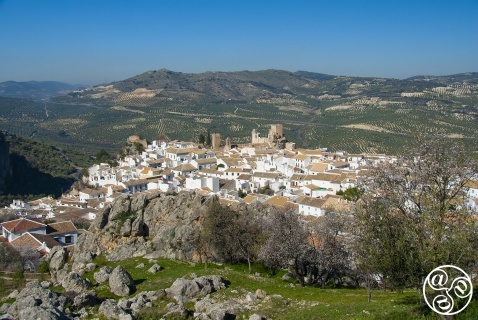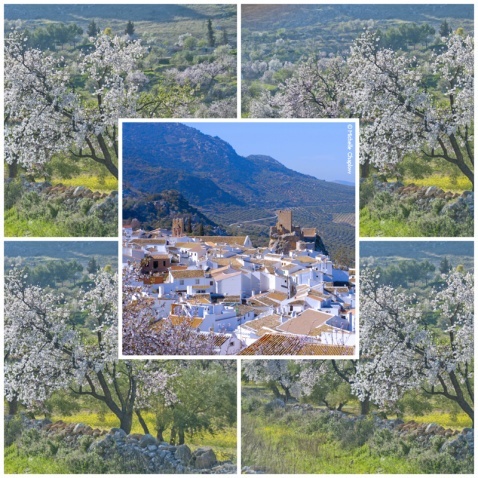
The village of Zuheros is like a picture postcard |
|

Zuheros one of the most stunning villages in Andalucia © Michelle Chaplow |
|
ZUHEROS
by Saskia Mier
Glaring light reflecting from chalky white walls against the Mediterranean blue sky is everybody's image of a "pueblo blanco" (white village). Zuheros is one of the best of these. It has around 640 inhabitants.
HISTORY
Zuheros was originally settled by the Ibericos Pleno to protect an ancient roadway known as the Camino de los Metedores, the smugglers track. The Romans followed shortly afterwards, leaving behind them relics found in Las Cuevas de los Murcielagos. Towards the end of the ninth century, Banu Himsi soldiers built a castle on the impregnable rocks, called Sujaira.
In the year 1240, the settlement was conquered by Fernando III, placing the castle under seigneurial jurisdiction and thus strengthening the border with the Nasrid Kingdom of Granada. Alfonso X "El Sabio" gave it to his son, Infante Don Juan, however, following the breach of an agreement, Sancho IV ordered a conquest for the Council of Códoba in 1293, so the village remains until today under its jurisdiction. Varying lords and their respective houses were in control of the village thereafter, until the abolition of the Señoríos. See more >
THINGS TO SEE
Castillo
The small fortress, nestled in rock, occupies a privileged position. Built by the Arabs in the ninth century, it now houses the remains of a Renaissance-style palace. It is located on Calle Nueva.
Parroquia de Nuestra Señora de los Remedios
This church was originally under a different invocation, Santa María, however, the current church's construction began in 1590. In 1696, the Baroque altarpiece was added. A series of reformations were carried out in the eighteenth century and the bell tower was added in 1795. The structure can be seen in its current state on Calle Horno o Párroco Rafael Linares.
Museo Arqueológico
The Archaeological Museum consists of a monographic exhibition of prehistoric and historical objects that have been found mainly in the Cueva de los Murciélagos.
Visitors can observe ceramics from as far back as the Neolithic period, decorated with almagra, elements of adornment and numerous stone and bone utensils. The materials of the Copper and Bronze Age are also striking. The museum is located in Plaza de la Paz.
Opening Times:
April-September, Tuesday-Friday, 10:00-14:00hrs and 17:00-19:00hrs.
April-September, Saturday, Sunday and Holidays, guided tours at 11:00, 12:30, 14:00, 17:00 and 18:30hrs.
October-March, Tuesday-Friday, 10:00-14:00hrs and 16:00-18:00hrs.
October-March, Saturday, Sunday and Holidays, guided tours at 11:00, 12:30, 14:00, 16:00 and 17:30hrs.
Price: (includes visit to Castle)
Adult, 2 euro
Children 6-12 years, 1,25 euro
It is advisable to reserve beforehand.
Tel: 957 69 45 45
Museo de Costumbres y Artes Populares Juan Fernández Cruz
The Juan Fernandez Cruz Museum of Customs and Popular Arts was established in honor of the pharmacist Juan Fernandez Cruz. Throughout his life, he collected antiques that make up 95% of the Museum's pieces. Located on Calle Santo.
Opening Times:
April-September, Tuesday-Thursday, visits by appointment only
April-September, Friday, 17:00-20:00hrs
April-September, Saturday, Sunday and Holidays, 10:30-14:30hrs and 17:00-20:00hrs
October-March, Tuesday-Thursday, visits by appointment only
October-March, Friday, 16:00-19:00hrs
October-March, Saturday, Sunday and Holidays, 10:30-14:30hrs and 16:00-19:00hrs
Price: Individual, 2, 50 euro
Children 6-12 years, 2, 00 euro
Tel: 957 69 46 17

THINGS TO SEE OUTSIDE THE VILLAGE
Museo Francisco Poyato
This Museum displays the house of painter Francisco Poyato Serrano, and is situated in a typical Andalusian enclosure built in the nineteenth century. His work is fundamentally surrealist, composed mainly of drawings, paintings and sculptures, which are divided into several rooms in the museum. It has been open to the public since 1984 and was extended in 2004, to mark its Twentieth Anniversary. With more than a hundred exhibitions and work distributed throughout the world, the works of this artist can be studied significantly from 1976, when he made his first exhibition. Since then, he has evolved into several trends, overcoming different periods, ranging from dark, medium colour, collages, colourist period, evolutionary period, to design and sculptural design, entering the year 2000 with a deep sculptural evolution and with architectural references. This artist always accompanies his exhibitions with a poetic recital of his own work, as literary support for his artistic ideas. Located on the CO-6209, Km0,800.
Opening Times:
Wednesday-Sunday, 11:00-14:00 and 17:00-20:00hrs (Winter)
Wednesday-Sunday, 11:00-14:00 and 18:00-21:00hrs (Summer)
Tel: 957 69 47 25
Cueva de los Murciélagos
The cave is named after the murciélagos (bats) that inhabit it. Known archaeologically throughout Europe, it is one of the most important Neolithic sites in Andalusia and the first in which Upper Palaeolithic art was uncovered. The visitor route, which partially runs through the cave, travels through several halls and corridors with paintings representing horses, bears and Paleolithic hinds, to men and schematic Neolithic goats. Located east of Zuheros, on the CV-247. Read more >
Opening Times:
April-September, Tuesday-Friday, guided tours at 12:30 and 17:30hrs
April-September, Saturday, Sunday and Holidays, guided tours at 11:00, 12:30, 14:00, 17:00 and 18:30hrs.
October-March, Tuesday-Friday, guided tours at 12:30 and 16:30hrs
October-March, Saturday, Sunday and Holidays, guided tours at 11:00, 12:30, 14:00, 16:00 and 17:30.
Price: Individual, 6 euro
Children 6-12 years, 5 euro
Those who have reservations will always have preference when accessing the cave.
Guided tours are limited to 30 people. It is advisable to book in advance.
Tel: 957 69 45 45
Ecomuseo
The Cueva de los Murciélagos Ecomuseum is an interpretation centre dedicated to the natural monument. The Ecomuseum serves as a prelude that will enrich your visit to this interesting cave, which is just 200m from the entrance of the Museum.
Opening Times:
Wednesday-Friday, 10:30-13:30hrs
April-September, Weekends and Holidays, 10:30-14:00 and 16:45-18:45hrs
October-March, Weekends and Holidays, 10:30-14:00 and 15:45-17:45hrs
Tel: 957 69 45 45
Observatorio Astronómico
Keen astronomers should make their way to the parking lot of Cueva de los Murciélagos for a real treat. There is a 4m dome and a MEADE LX-200 12-inch telescope. The objective of this observatory is to spread knowledge of the cosmos, either to the naked eye or through direct ocular observation. Located east of Zuheros, on the CV-247.
Hotels in Zuheros
Book Hotels in Zuheros
COUNTRYSIDE WALKS
Ideally situated on the fringe of the Sierras Subbéticas Natural Park, Zuheros is now becoming a popular base for walkers and painters; the Zuhayra (Tel: 957 694693) offers extremely good accommodation and is splendidly run by the Abalos family.
Popular walking routes include Sendero del Río Bailón and Sendero del Cañon del Río Bailón.
The old railway which passes the village has been transformed into a Via Verde and serves as a walking and cycling route. Bikes can be hired from the hotels.
Festivals in Zuheros
Festivals that are popular in Zuheros are Cabalgata Reyes Magos, Carnival, La Candelaria, Semana Santa, Día de la Cruz, Romería de San Isidro Labrador and Fiestas Patronales en honor a la Virgen de los Remedios. More>
GASTRONOMY
When visiting Zuheros, try local dishes such as sobrehusa (bean and egg stew), cachorreñas (cod and orange), mojete (tomato, tuna and onion salad), clavellina (a specific dish only found in Zuheros), chuletas de cordero rebozadas (lamb chops), tortillas en salsa (omlette), conejo al ajillo (garlic rabbit) and setas rebozadas (battered mushrooms). Sweet treats include roscos melados (aniseed donuts), pestiños (honey pastries), pan de higo (dried fig cake) and requesones con miel y azúcar (curd with honey and sugar). Why not try the local drink, resol, made with coffee, aniseed liqueur and orange?
HANDICRAFTS
The village is famed for its cheese factory, Las Balanchares, with locally bred goats from the Sierras providing the milk for this internationally known product. Cheese can be bought directly from the factory.
NEARBY PLACES
The neighbouring villages to Zuheros are Doña Mencía, Luque and Baena.

